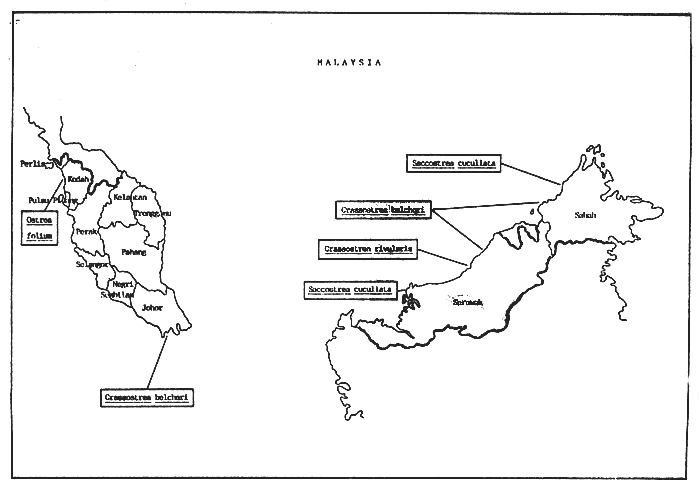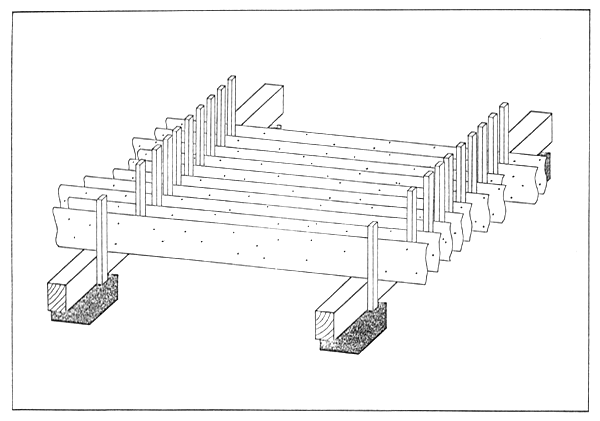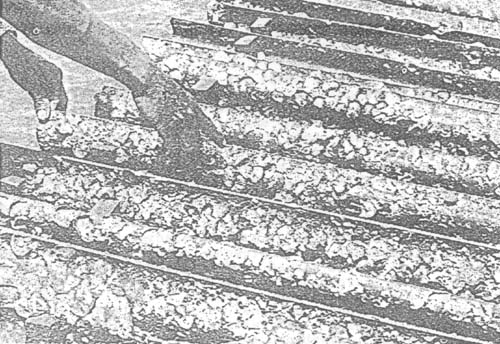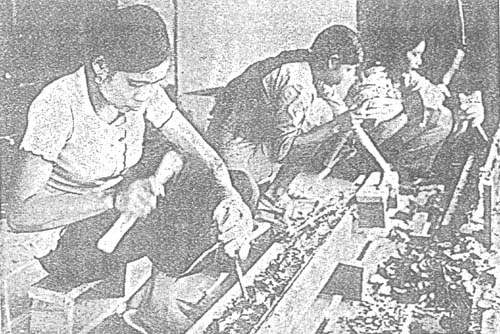Oyster culture in Malaysia is not well developed with current
production being about 10 mt a year (Ng, 1987). Culture
experiments were carried out by Okada in the early 1960's (Okada,
1963). Four species of oysters are found in Malaysia:
Crassostrea belcheri, C. rivularis, Saccostrea cucullata and
Ostrea folium. The first species is the one cultured in the
country, while experiments on the culture of the other species
are being carried out. C. belcheri are currently being cultured,
mostly on a part-time basis, in the Muar River, Johore. In Kedah
State culture of the flat oyster (O. folium) is being carried out
using the rack and raft culture methods. In Sabah both C.
belcheri and S. cucullata are being cultured using the rack
method. Oyster culture is also practised on a small scale in the
State of Sarawak (Table 7 and Fig. 13).
Oyster production data are available from 1982 to 1984 (Figure
14). Total production of mollusc in Malaysia in 1984 was about
64,080 MT of which 61,650 MT (96.2 %) were from the production of
cockle (Anadara granosa), about 1,995 MT (3.0 %) of carpet clam
(Paphia undulata), 425 MT (0.66 %) of mussel (Perna viridis) and
about 10 MT (1.4 %) of oysters (Crassostrea spp.). While oyster
production is low compared to the production of other bivalve
species, oyster culture is certainly receiving particular
attention from various institutions involved in bivalve work.
Three culture methods are practised in Malaysia. The raft or
floating method is employed for oysters grown in riverine
conditions where siltation is relatively heavy and tidal range is
considerable. The pole and rack methods are intertidal fixed-culture
methods used for both spat collection and grow-out.
In Peninsular Malaysia spatfall of most oyster species occurs
throughout the year but two main peaks can be distinguished. In
the case of oysters in Muar (Johore) and Pulau Langkawi (Kedah)
the first peak is generally observed from March to May and the
second from September to December. Two peaks are similarly
observed for oysters in the States of Sabah and Sarawak: the
first from April to June the second from October to November.
Spats are usually collected in or in the vicinities of areas
where a natural population of parent oysters is present.
Monitoring of spatfall is practised by analyzing test collectors
placed in various localities. This activity is essential if the
bulk of the collectors are to be placed on site without being
fouled by barnacles, algae and silt. A variety of collectors
either on the bottom or off bottom are used in Malaysia according
to the area. In the Muar River, Johore, oyster shells are found
to be most suitable for collecting spat of the large oyster, C.
belcheri. In Pulau Langkawi polyethylene ropes and nets are used
as collectors for the flat oyster O. folium, in Sabah and Sarawak
(Eastern Malaysia) corrugated asbestos roofing is the best cultch
material (Fig. 15 and Plates 6 and 7)) (Chin and Lim, 1975; Choo,
1983).
The bottom oyster culture method as it is practised in the Muar
River requires no special grow-out grounds. Usually the same
site is used for collecting the spat and for on-growing. The raft
culture method for the flat oyster (O. folium) also requires no
grow-out grounds, as the spat are left on the collectors until
they reach marketable size. However, thinning is usually
necessary when the collectors become too heavy. In Sabah the
spats are retained in boxes on racks for about 4–6 months and
then removed from the cultch and transferred to trays suspended
from rafts (Ng et al., 1982). In Sarawak, collectors are usually
transferred from the spatfall areas to more sheltered on-growing
grounds. The growth rates of the above oysters vary according to
species and locality. C. belcheri cultured in Johore and Sabah
attains the commercial size of 12–14 cm after 1 year, whereas the
flat oyster O. folium cultured in Pulau Langkawi attains a
commercial length of 6–7 cm in 10–12 months. In Sarawak the
small oyster S. cucullata attains an average size of 4.5 cm in 1
year, while C. rivularis shows a much faster growth and easily
grows to an average length of 7.5 cm in 1 year.
Harvesting is carried out manually. No mechanical devices
(dredges) have been introduced in the areas where bottom culture
is practised because of the fear of damaging the oyster beds.
Only oysters of marketable size are collected.
The main constraints affecting oyster culture in Peninsular
Malaysia are fouling from other sedentary organisms and algae,
predation by xanthid crabs (Myomenippe granulosa) and starfish,
siltation as well as relatively poor spatfalls in some areas.
The lack of sanitation measures is an increasing concern within
the bivalve industry in general. Presently no sanitation control
measures are strictly enforced to ensure the quality of cultured
bivalves.
Oyster culture in Peninsular Malaysia is still in the initial
stages of development and there is a considerable number of
problems to be resolved before the commercial culture of oysters
can be carried out. Further research into adapting established
culture methods from countries in the region as well as
identifying further suitable sites will certainly help towards
the commercial propagation of oysters in Malaysia.
Research efforts on oyster culture techniques and identification
of potential sites are underway (under BOBP funding) and it is
hoped that the information gathered will enable further
development and proper management of this resource.
With regard to bivalve purification a suitable system is being
developed with inputs from ASEAN/Canada and ASEAN/Australia.
In Sabah and Sarawak, studies are concentrated on the further
development of culture techniques and on the economic aspects of
oyster culture.
Table 7. Distribution and main culture areas of commercially important oyster species in Malaysia.
| SPECIES | STATE | LOCALITY | NOTES |
| Crassostrea belcheri | Johore | Muar River | Culture and natural grounds. Bottom and raft culture are practiced. Approximate area of 18 ha. |
| Sabah | Sandakan, Tawau and Labuan | Culture and natural grounds. Rack and raft culture are practiced. | |
| Sarawak | Cowie Bay | Spat are collected from tributaries of Cowie Bay. Small-scale activities. Raft, Rack and pole culture are practiced. | |
| Crassostrea rivularis | Sarawak | Culture and natural grounds. Rack and raft culture are practiced. | |
| Saccostrea cucullata | Sabah | Culture and natural grounds. Rack and raft culture are practiced. | |
| Sarawak | Culture and natural grounds. Rack and raft culture are practiced. | ||
| Ostrea folium | Kedah | Pulau Langkawi | Culture and natural grounds. Rack and raft culture are practiced. |

Figure 13: Major farming areas of the four commercially important oyster species in Malaysia.

Figure 14: Oyster production data in Malaysia from 1982 to 1984. (Source: Ng, F. O., 1987).

Figure 15: Corrugated asbestos sheets on racks for spat collection.

Plate 4: Young oysters (2–5 cm shell length) attached on asbestos sheets.

Plate 5: Separation of young oysters from asbestos sheets.